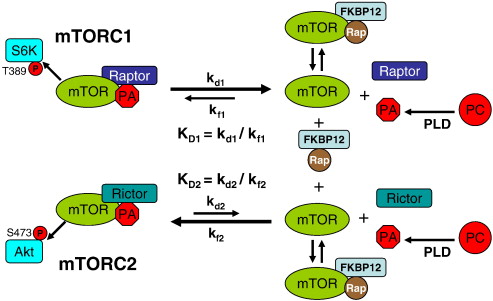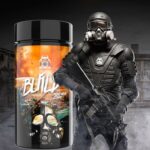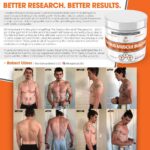There's a new muscle-building ingredient coming soon to the supplement marketplace, and it could be a real game-changer, unlike so many other recent supplement industry 'innovations'.
From the researchers at Chemi Nutra (A subsidiary of Italian pharmaceutical company ITALIFARMCO) comes the novel ingredient, phosphatidic acid.
The early research results are extremely promising: significant mass and strength gains, and significant scientific backing for the ingredient, both in models and in studies on trained athletes.
The chemical background of phosphatidic acid and where it comes from
Phosphatidic Acid is a phospholipid, a diglyceride fat with a phosphate group bonded to the glycerol backbone. Phospholipids are a major constituent of cell membranes, and influence a number of mechanisms in cell metabolism.
In Chemi Nutra's case, they are extracting their phosphatidic acid from lecithin, a major source of many various phospholipids such as one of their other patented ingredients, phosphatidylserine.
How does it work?
We all understand that muscles grow as a response to lifting, but how does this work
Scientists have identified a protein named " mammalian target of rapamycin" -- or mTOR for short -- as a key regulator of this muscle growth. The term for this is 'mechanically-induced mTOR signalling'.
Over the past few years as a result of this expanded knowledge of the mechanical functions behind muscle growth you've probably seen a lot of supplements talking about increasing mTOR signalling, with varying levels of success.
Laboratory breakthroughs in muscle science

Chemi Nutra will be Marketing Phosphatidic Acid
So, what does this have to do with phosphatidic acid? Researchers weren't satisfied with simply knowing that mechanical signalling of this protein causes muscle growth, they wanted to know exactly what is involved in that signalling.
Enter Troy Hornberger at the University of Wisconsin.
Through a fascinating series of research (if you're a science junkie that is) using live cellular level imaging of muscle cells under contraction, the pathway and compound directly responsible for mechanical-induced mTOR signalling were identified as an enzyme phospholipase D, which degrades phosphatidylcholine into choline and phosphatidic acid, which directly activates mTOR. (1, 2, 3, 4, 5, 6, 7, 8).
Putting it to the test in humans
These breakthroughs in our understanding of muscle growth and mTOR signalling have led to a great deal of interest in how to apply this new knowledge to humans, as a potential treatment for diseases and for use in enhancing sports performance. This led to programs such as UCF's Human Performance Lab to conduct studies in humans.
Bioavailability
Of utmost importance when determining the usefulness of a compound for supplementation is determining if it is bioavailable, and can reach the desired tissues intact. In a study on humans, it was determined that phosphatidic acid has a high oral bioavailability in humans and increases plasma phosphatidic acid levels effectively. (9)
The First Study - 12.7% Squat Boost
In the first human study, trained athletes were given 750mg of phosphatidic acid daily for 8 weeks and followed a rigid resistance training program. At the end of the trial, the supplementation group gained 12.7% squat strength (9.3% for placebo) and a 2.6% increase in lean body mass (0.1% for placebo).
The study subjects consumed nearly identical calories over the course of the study. This study was a small one, and these benefits were not large enough to be deemed statistically significant due to those limitations, however they did generate enough interest to justify further human study. ( 10)
Second Study - 5lb lean muscle gain
In the next human study, following the same protocols (750mg daily, resistance trained athletes, 8 weeks), the phosphatidic acid again performed well. The supplement group ended off with significantly better lean body mass gains, adding 5 pounds of muscle compared to the controls 2.5 pounds.
Additionally, there was a statistically significant increase in leg press over control with the supplement group adding 115 pounds and the control just 70. Another trend that was noted, albeit not statistically significant was one of increased fat loss in the supplement group (-2.8 lbs compared to -1.1 lbs). (11)
These Weren't "Beginner Gains"
These benefits might seem modest but there are a couple of very important things to remember here. First off, the studies were performed on trained healthy young males -- these weren't "beginner gains".
Most studies on muscle building compounds are performed in the elderly, sick, obese, or untrained. These groups stand to make rapid gains that look impressive on paper but do not convert well to people who are already in shape and trying to build more muscle.
These studies were done right, and it suggests that this is eventually going to be marketed and available as a muscle builder.

Phosphatidic Acid - MTOR Signaling
Is it Safe?
The next thing you're probably wondering is whether or not this ingredient is safe to take.
Fortunately, as the backers of this ingredient are seeking FDA approval, and a patent on this ingredient, they also performed a safety analysis in humans, concluding that there were: "no differences at baseline in blood chemistry and hematology between the CON and EXP supplemented groups" and "no differences were observed in urinalysis values between the groups" (12)
So far, it is looking very safe and side-effect free.
Where to buy?
No phosphatidic acid supplements have hit the market yet, but they should be coming soon. Chemi Nutra is currently marketing its Mediator trademarked phosphatidic acid to supplement companies, and ramping up that marketing since the release of their latest studies on the ingredient.
We're excited about the potential of this ingredient though, so rest assured, as soon as we hear something, we'll update this page with information on what products to buy and where to buy them. You can also sign up for our email list to receive updates on this and other supplement news.
References
- Cell Cycle. 2006 Jul;5(13):1391-6. Epub 2006 Jul 1.
- Proc Natl Acad Sci U S A. 2006 March 21; 103(12): 4741–4746.
- PLoS One. 2012;7(10):e47258. doi: 10.1371/journal.pone.0047258. Epub 2012 Oct 15.
- Trends Endocrinol Metab. 2013 Jun;24(6):272-8. doi: 10.1016/j.tem.2013.02.003. Epub 2013 Mar 16.
- J Physiol. 2009 Jul 15;587(Pt 14):3691-701. doi: 10.1113/jphysiol.2009.173609. Epub 2009 May 26.
- FASEB J. 2011 Mar;25(3):1028-39. doi: 10.1096/fj.10-168799. Epub 2010 Dec 8.
- Cell Signal. 2011 Dec;23(12):1896-906. doi: 10.1016/j.cellsig.2011.07.013. Epub 2011 Jul 23.
- J Physiol. 2011 Nov 15;589(Pt 22):5485-501. doi: 10.1113/jphysiol.2011.218255. Epub 2011 Sep 26.
- Purpura M, Jager R, Joy JM, Lowery RP, Moore JD, Wilson JM. Effect of Oral Administration of Soy-Derived Phosphatidic ACid on Concentrations of Phosphatidic Acid and lyso-Phosphatidic Acid Molecular Species in Human Plasma. Poster Presentation at the ISSN Conference 2013.
- J Int Soc Sports Nutr. 2012 Oct 5;9(1):47. doi: 10.1186/1550-2783-9-47
- Joy JM, Lowery RP, Dudeck JE, De-Souza EO, Jager R, McCleary SA, Wilson SMC, Purpura M, Wilson JM. Phosphatidic Acid Supplementation Increases Skeletal Muscle Hypertrophy and Strength. Poster presentation at the ISSN Conference 2013.
- Dudeck JE, Joy JM, Lowery RP, De Souza EO, Jager R, McCleary SA, Wilson SMC, Purpur M, Wilson JM. Safety of Soy-Derived Phosphatidic Acid Supplementation in Healthy Young Males. Poster presentation at the ISSN Conference 2013
Phosphatidic Acid News on PricePlow
-
Feb 19, 2024 
Product News
Jacked Factory Form XT was created.
Categories: Ashwagandha, Muscle Building Supplements, Phosphatidic Acid -
Jun 18, 2021 
YouTube Video
The Muscle Building Supplement of 2021! UNBOUND BYLD Explained -
Feb 17, 2019 
Blog Post
Muscle Building Supplements: The Next Generation (2019)
Muscle Building Supplements: The 2016 Guide. We all know about creatine, protein, and amino acids... but what are the NEXT generation muscle builders? -
Dec 12, 2018 
YouTube Video
Outbreak Nutrition BUILD: Muscle Builder Ingredients -
Nov 19, 2018 
Blog Post
Outbreak Nutrition BUILD: Muscle-Builder of the Apocalypse
Outbreak Nutrition's BUILD Supplement is a muscle-builder that goes beyond creatine with phosphatidic acid, ellagic acid, ursolic acid, and laxogenin! -
Oct 23, 2018 
YouTube Video
The Genius Brand Muscle Builder Ingredient Breakdown! Worth it?! -
Oct 16, 2018 
Blog Post
The Genius Muscle Builder: Natural Muscle Gains Like a Genius
The Genius Muscle Builder is a human research backed muscle building powder that takes things to the next level AFTER your creatine/betaine basics. -
Oct 15, 2017 
Blog Post
Keto Connect with Mike: Supplements for Keto | Episode #004
Need guidance about supplements for keto dieters? Check out Mike's 2017 Keto Connect podcast interview on "Keto for Normies" with Matt & Megha! -
Apr 07, 2015 
Blog Post
Phosphatidic Acid – The Next Great Muscle Builder?!
Phosphatidic Acid looks like the breakout muscle building supplement of 2015. Read about PA dosage, research, and side effects, and where to buy it! -
Jan 01, 2015 
Blog Post
The Top 10 Supplement Industry News Stories of 2014
PricePlow goes over the Top 10 Supplement Industry News Stories of 2014
Sign up for future Phosphatidic Acid news!
Click the button below to sign up for future Phosphatidic Acid news, deals, coupons, and reviews!
Phosphatidic Acid Reviews & Videos
-
Jun 18, 2021The Muscle Building Supplement of 2021! UNBOUND BYLD Explained
-
Dec 12, 2018Outbreak Nutrition BUILD: Muscle Builder Ingredients
-
Oct 23, 2018The Genius Brand Muscle Builder Ingredient Breakdown! Worth it?!
Subscribe for more Phosphatidic Acid news and alerts!
Subscribe to PricePlow on YouTube, follow PricePlow on Instagram or click the button below to sign up for our latest Phosphatidic Acid news and reviews!









